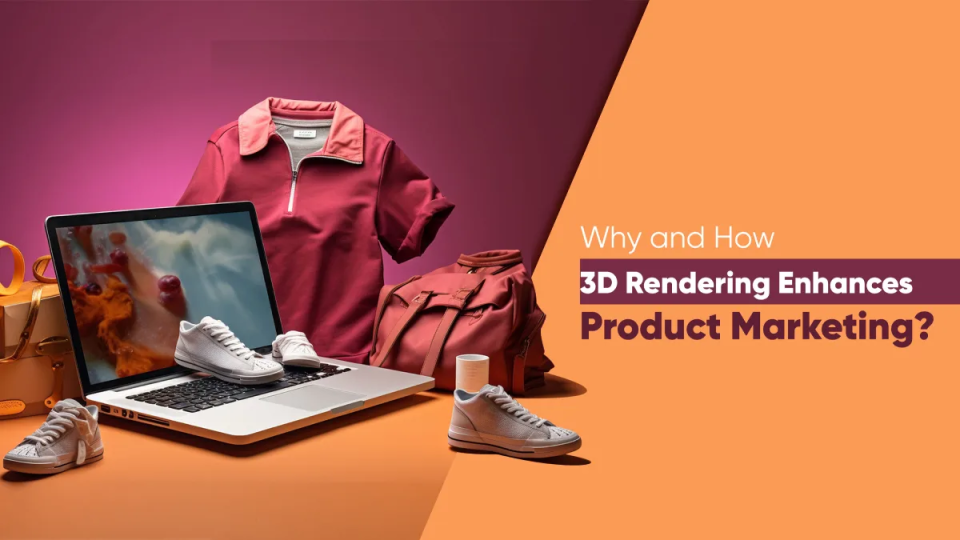Are you having trouble standing out in the busy Ecommerce market? Regular product photos can be pretty bland, making customers second-guess their choices and causing more returns. Enter 3D rendering services, a powerful tool that's changing product marketing with stunning, interactive visuals. Studies show that using 3D product visualization can increase conversion rates by up to 40%. 3D rendering creates engaging visuals and helps lower marketing costs.
In this guide, we'll uncover why and how 3D rendering enhances product marketing, from slashing costs to improving customer engagement with photorealistic rendering. Discover the benefits of 3D product visualization, real-world success stories, and emerging product marketing trends. Ready to level up your brand with some awesome 3D product visuals? Let's dive into how this cool tech can really boost your sales!
What is 3D Rendering?
3D rendering turns digital 3D models into high-quality 2D images or animated sequences. This process makes these images look like real-world environments. It uses complex algorithms to analyze a model's shape, materials, lighting, and camera angles. This process creates final photos that often look just like real photographs. This level of photorealism is achieved by precisely replicating how light interacts with different surfaces, be it metal, fabric, glass, or skin, capturing fine details such as reflections, shadows, depth, and textures.
With AI-powered rendering tools, 3D rendering is now faster and more accurate. AI can do automated tasks like improving textures, adjusting lighting, and increasing resolution. This helps artists to produce highly realistic images much quicker than traditional methods. This is especially beneficial in fields like marketing, architecture, eCommerce, gaming, and product design, where visuals can greatly affect how customers see and decide on products.
Ultimately, 3D rendering bridges the gap between imagination and reality.
As technology grows, it changes how brands show their products, tell their stories, and connect with customers. They use engaging and high-quality visual content to do this.
Key Benefits of 3D Rendering in Product Marketing
3D Rendering in Product Marketing is a game-changer for brands looking to captivate audiences and boost conversions. It goes beyond pretty pictures; it's about creating immersive, flexible, cost-effective visuals that drive more results.
Time-to-Market Faster
Timelines are generally limited in traditional product photography by the availability of prototypes, setup locations, shipping arrangements, and manufacturing itself. Such limitations may hinder vital product launches or marketing campaigns. 3D rendering removes such barriers. Brands can now establish marketing campaigns even before the actual existence of the product.
The moment a design is completed in CAD or 3D software, it can be quickly rendered out to high-quality images or video ready for use on websites, ads, and catalogs. This improved time-to-market provides a winning advantage for companies, allowing pre-orders, early word-of-mouth, and swift revenue.
Customization Without Extra Expense
With traditional photography, having a product in several colors, textures, or layouts requires taking a new shoot of each type, putting a huge time and cost burden. With 3D rendering, it is just one model that can be infinitely modified. You can change materials, lighting, attachments, or turnabouts, all with ease, without ever touching the real product.
This flexibility not only reduces production costs but also provides teams the ability to build hyper-personalized experiences for different markets, customer segments, or channels. Whether it's showing how a couch would appear in "navy blue velvet" or how a sneaker would navigate a rocky landscape, 3D visualization propels your product narrative without launching your budget into rotation.
High Visual Appeal That Drives Conversions
Modern viewers scroll quickly, and only halting images hold them up. Photorealistic 3D images are crafted to attract attention. They mimic real-world lighting, depth, and material realism so convincingly that clients often wonder if they're not photographs. But it's not just about looks. They drive commercial outcomes.
Research confirms that 3D images can increase customer interaction by as much as 80% in industries like clothing, furniture, consumer electronics, and automotive. Interactive 3D viewers, turntables, or lifestyle renders can boost time-on-page, reduce returns, and ultimately drive more conversions, making them a solid option in any performance marketing campaign.
How 3D Rendering Transforms Marketing Strategies
From Static to Interactive Experiences
Modern consumers require more interaction, immersion, and control than two-dimensional, lifeless images. This is the reason why interactive 3D product browsers and high-end 3D rendering-driven virtual windows are catching up fast with enterprises. They enable users to rotate the product, zoom in and out, see textures, and see products from any angle, delivering an in-store-like shopping experience online.
Whether it's a fashion product, furniture, or a high-end appliance, this amount of interaction builds confidence and faith in the buying decision. Therefore, brands experience lower return rates, higher dwell time, and healthier conversion metrics, activating passive browsers into active participants in the buying process.
Facilitates Omnichannel Consistency
3D assets are flexible by nature, allowing brands to have one consistent visual identity throughout touchpoints and platforms. A 3D model created can be reused at will for eCommerce product pages, social media ad campaigns, AR/VR experiences, mobile app designs, in-store packaging images, and printed catalogs. Not only does this provide visual consistency and brand coherence, but it also optimizes content creation workflows.
Rather than ordering up new shoots or renders for each use case, product and marketing teams can tap a shared 3D asset library, saving time, money, and operational overhead by countless percentages. As customers flow effortlessly across channels, 3D rendering makes every channel look and feel the same.
Richens Brand Storytelling
In a busy online marketplace, it's as much about how you narrate your product story as the product itself. 3D visualization unlocks new creative paths to produce emotionally engaging, cinematic content that quickly brings and expresses value. By employing realistic lighting, movement, shadows, and custom environments, brands can dramatize detail, reveal functionality, or simply make a product look better to an extent that traditional photography can't match.
Whether it's a lingering pan over a high-end watch or a dramatic lighting reveal of a new sneaker silhouette, 3D storytelling renders products as experiences, resulting in content that not just stops the scroll, but one that creates desire and action.
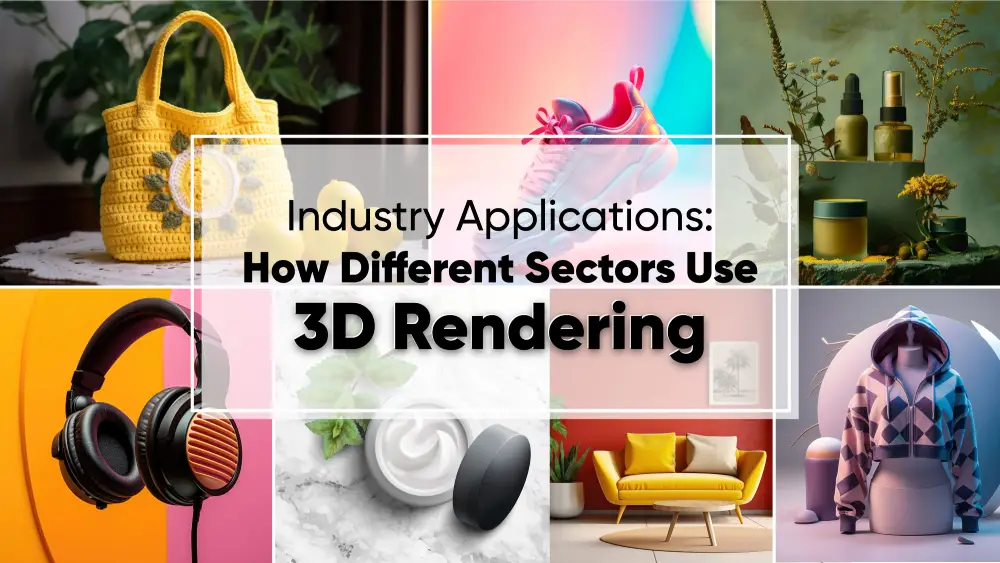
Industry Applications: How Different Sectors Use 3D Rendering
Many industries are using 3D visualization techniques to improve product marketing. This helps them attract customers and improve their operations. Here are some ways different sectors are using 3D rendering to stay competitive:
eCommerce & Retail
In online shopping, customers can't touch or try products before buying. 3D product visualization helps solve this problem. Many fashion, furniture, eyewear, and consumer goods brands are now using 3D rendering to show realistic product images. These images highlight every angle, material, and detail.
This engaging experience allows shoppers to make better purchase decisions, which reduces product returns and increases buyer confidence. Interactive 3D viewers and AR try-ons are becoming standard tools in eCommerce. They help brands stand out and significantly improve sales conversion rates.
The KOW Company has been at the forefront of this transformation, helping eCommerce brands bring their catalogs to life through advanced 3D modeling, photorealistic rendering, and interactive product viewers. From virtual try-ons to dynamic lifestyle renders, The KOW Company empowers retailers to elevate their digital storefronts and convert browsers into loyal buyers. As a result, interactive 3D viewers and AR try-ons are now becoming standard tools in eCommerce, helping brands stand out in a competitive marketplace and dramatically improve conversion rates.
Architecture & Real Estate
For architects, developers, and real estate marketers, 3D rendering offers a powerful way to communicate spatial ideas before they physically exist. With 3D floor plans, virtual staging, and full-scale walkthroughs, potential buyers or tenants can explore interiors, exteriors, and entire environments remotely.
This is especially valuable during pre-construction sales phases or for international investors. Photorealistic renders of lighting, materials, landscaping, and interior décor allow stakeholders to visualize the end result, speeding up decision-making and elevating project presentations to a new level of professionalism through architectural visualization.
Automotive & Electronics
Automotive companies rely on 3D rendering to display vehicles with customizable options like colors, rims, or interiors without needing physical prototypes. Similarly, electronics brands use 3D product visualization to highlight intricate details of gadgets like smartphones, offering 360-degree views or exploded diagrams. This approach fits with current product marketing trends. It builds customer trust and boosts sales.
Health & Beauty
Before packaging is finalized or formulas are produced, beauty brands can use 3D rendering to prototype, promote, and position their products in the market. From skincare jars to makeup palettes, 3D visuals enable marketers to showcase textures, finishes, and even application techniques without waiting for physical samples.
These visuals can be animated to show how a cream spreads on skin, how a lipstick shines under different lighting, or how a product sits on a vanity table. This approach speeds up launch timelines and provides high-quality visual content for ads, influencer kits, and retail displays before production begins.
Success Stories: Brands Winning with 3D Rendering
3D rendering services have helped many brands change their marketing strategies. They show the great value of 3D product visualization in real-life situations. Here are some success stories of brands using 3D rendering for product marketing to achieve great results:
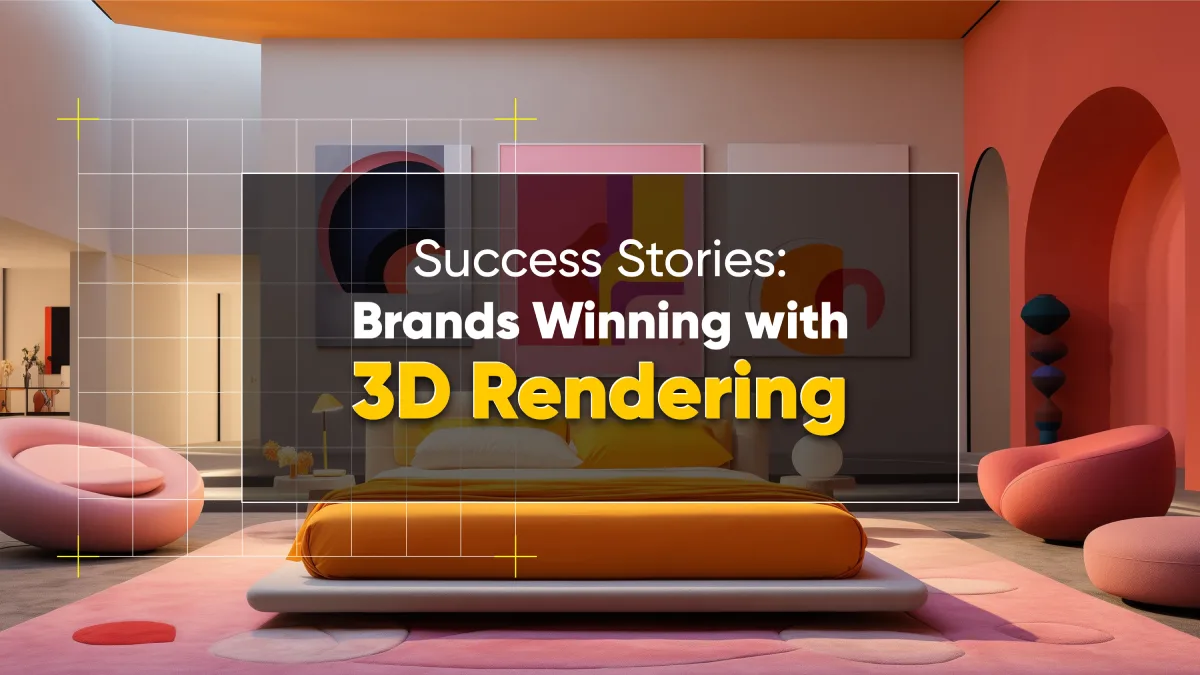
IKEA: Scaling Product Visualization with CGI
Global furniture giant IKEA has redefined product visualization by embracing 3D rendering and CGI at scale. Today, over 75% of the images in IKEA's catalog are computer-generated, not photographed. This strategic shift has allowed the company to greatly reduce production costs, minimize photoshoot logistics, and accelerate time-to-market for new collections.
Beyond cost savings, CGI offers IKEA the flexibility to visualize thousands of product combinations from fabric and color variations to room settings without physically staging each one. It also ensures visual consistency across global markets, enabling a seamless omnichannel experience whether a customer is browsing a printed catalog, website, or mobile app.
L'Oréal: Speeding Up Product Development with 3D Visualization
As a global leader in beauty, L'Oréal uses 3D rendering to streamline its packaging and product design workflows. Before investing in physical prototypes, the brand relies on high-quality 3D models to visualize how products like skincare bottles, makeup compacts, or fragrances will look in real-world settings. This revs internal decision-making, reduces development cycles, and enables faster alignment between product, marketing, and retail teams. L'Oréal's use of 3D visualization empowers the brand to test multiple design directions, fine-tune branding elements, and launch with greater confidence, all while reducing environmental waste from unnecessary samples.
Wayfair: Improving Shopper Experience with 3D & AR
Home goods eCommerce giant Wayfair has embraced interactive 3D and augmented reality (AR) to elevate its customer experience. Through its "View in Room" AR feature and 3D product viewers, Wayfair lets shoppers virtually place furniture and décor in their own spaces before purchasing.
This technology makes shopping easier and more fun by helping customers see exactly how items will look in terms of size, color, and fit. As a result, shoppers are happier and there are fewer returns! By investing in 3D rendering, Wayfair has really set itself apart in a busy market. They're creating a more enjoyable and trusting shopping experience that makes it easier for customers to make their purchases confidently!
How 3D Rendering Boosts ROI and Sales Metrics
Higher Conversion Rates
Today's consumers are visual and tech-savvy. Static images simply can't do a product justice, but interactive 3D graphics can. When customers are able to rotate, zoom, and examine a product from any position, their trust in purchasing significantly increases.

No matter if it's a sofa, a makeup bottle, or a shoe, virtual discovery of detail mimics an in-store experience that forms a stronger product connection. Double-digit conversion rate increases typically result from brands using 3D product visualization, particularly in product categories such as furniture, clothing, and electronics.
Reduced Return Rates
One of the greatest advantages of 3D rendering is reconciling customer expectations with product reality. On eCommerce sites, returns are caused by unclear photos, deceptive colors, or ambiguities about size and features. HD 3D models and AR previews banish ambiguity. Shoppers can visualize precisely how a product looks, fits, or works in their environment, reducing surprises and discontent at delivery.
In reality, most brands using 3D visualization and virtual try-ons report their product return rates drastically decreasing, shaving costs of reverse logistics, restocking, and customer service.
Lower Long-Term Costs
Whereas 3D modeling and rendering can be an initial cost, particularly when building a library of products or shooting expensive scenes, the ROI over time is huge. Brands no longer have to allocate funds for the recurring costs of studio rentals, pro models, photographers, stylists, and physical samples.
A single 3D asset can be reused across many channels, from websites and social media to AR, print, and packaging, without the expense of remakes. This facilitates smoother content creation. Gradually, companies have found 3D workflows to be not only more efficient but also cheaper, particularly when there are frequent product updates or large catalogs to maintain.
Why Your Business Needs 3D Rendering Today
3D rendering is an important tool for any business, regardless of its size or industry. It has become accessible and affordable for startups, small businesses, and growing brands, not just large corporations. Using 3D rendering can give your business a competitive advantage. Here's why you should act now.
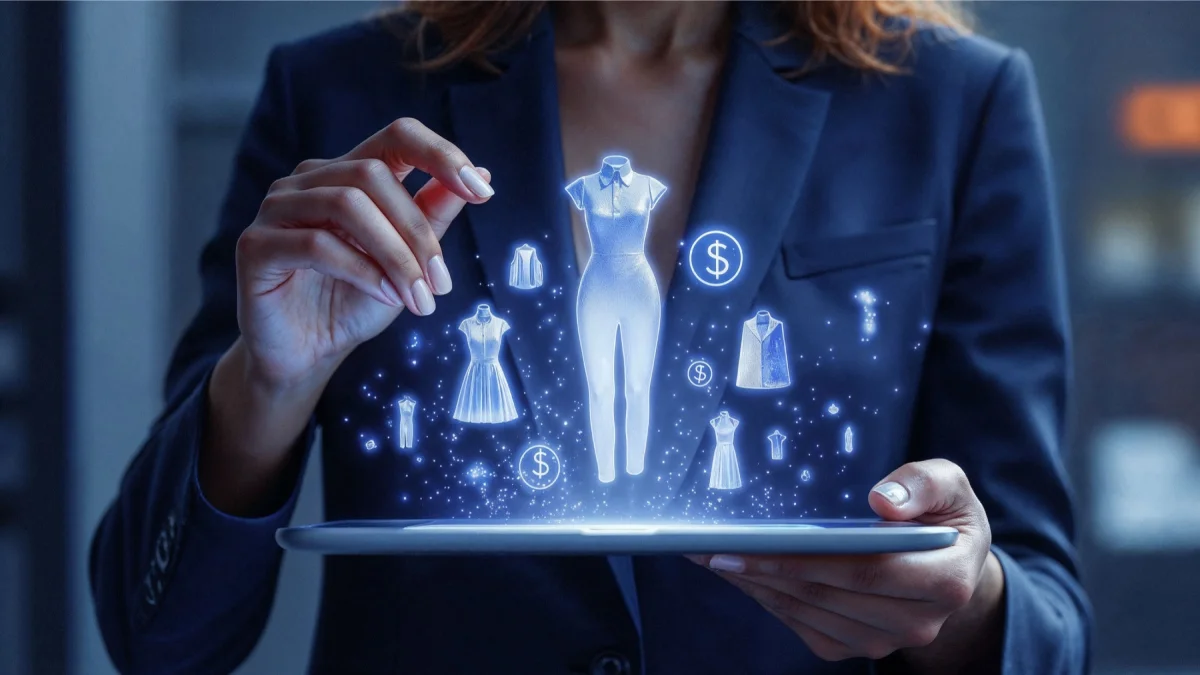
Stay Ahead in the Competitive Online Marketplace
Today's digital economy moves fast, and brands that fail to innovate risk falling behind. 3D rendering helps your business stand out with eye-catching, interactive, and photorealistic visuals that engage today's visual-first consumers. Whether you're selling online or pitching to clients, high-quality 3D content signals professionalism, modernity, and attention to detail, key differentiators in saturated markets.
Improve Customer Experience and Engagement
With 3D visuals, customers can see how a product looks and works. They can explore your products confidently, which reduces uncertainty and boosts satisfaction. These experiences keep them on your site longer, increase engagement, and make them more likely to buy. Whether you sell furniture, fashion, electronics, or cosmetics, seeing is believing. 3D helps make that belief real.
Be Ready for the Future: AI 3D Rendering, AR, and VR
3D rendering is now more than just a static image. It is the backbone of modern trends like AI-powered rendering, Augmented Reality (AR), and Virtual Reality (VR). Investing in 3D today creates assets that can grow with your brand. This includes features like virtual try-ons, immersive showrooms, and AI-generated content at scale. Prepare your visual strategy for the future while your competitors are still catching up.
Scale Content Creation with Fewer Resources
Producing traditional photoshoots for every product variation, colorway, or use case is time-consuming and expensive. 3D rendering flips this equation. Once a model is created, you can generate endless variations, scenes, and formats, all without reshooting. This dramatically increases your speed, flexibility, and content output, helping you scale marketing campaigns while keeping costs under control.
Is 3D Rendering Expensive?
Not necessarily. Many 3D service providers, like The KOW Company, offer flexible and affordable packages for small businesses and startups. Whether you need a few product images or a full visual catalog, these solutions are usually customizable to fit your budget.
Even more importantly, the long-term return on investment (ROI) through better engagement, fewer returns, and lower content production costs often far outweighs the initial setup expense. Look at it as more than just throwing money at marketing; it's a savvy investment in your brand's future.
Future Trends in 3D Rendering for Marketing
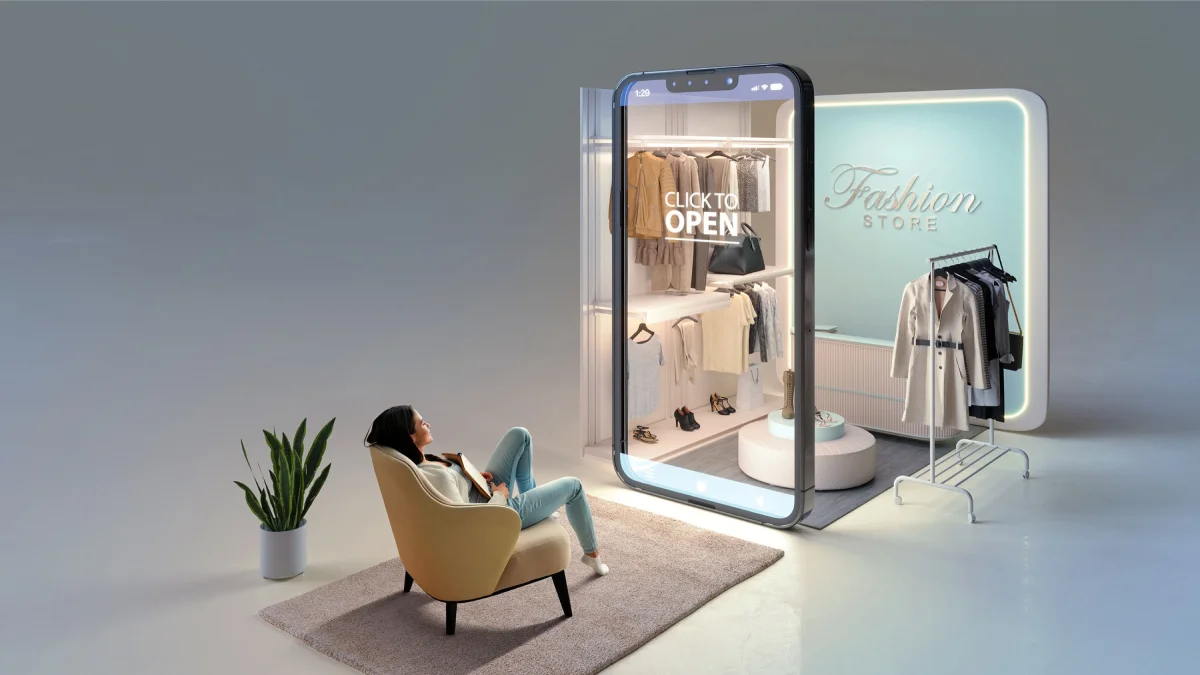
The future of 3D product visualization promises to deliver even more immersive and personalized experiences, keeping brands at the forefront of product marketing trends.
- Augmented Reality (AR) Integration: AR with 3D rendering will let consumers interact with products in real-world settings, like trying virtual clothing, boosting customer engagement.
- Virtual Reality (VR) Showrooms: VR and photorealistic rendering will create immersive digital stores for exploring products, revolutionizing sectors like automotive and real estate.
- AI-Driven Personalization: AI combined with 3D rendering services will create custom visuals in real-time. This means you can personalize things like cars or beauty products to make them more relevant to your needs.
- Real-Time Rendering Advancements: Faster, cloud-based 3D product visualization will enable on-the-fly campaign adjustments, aligning with product marketing trends.
- Sustainability Through Digital Prototyping: 3D rendering will cut waste by replacing physical samples with virtual prototypes, supporting eco-friendly branding.
Conclusion
3D rendering into your product marketing is no longer optional; it's essential. Whether you aim to increase engagement, cut costs, or offer next-level visual experiences, 3D product visualization is the future. As consumer expectations grow, so should your visual strategy.
Invest in professional 3D rendering services today and stay ahead of the competition. From photorealistic rendering to AI-powered 3D visuals, the possibilities are endless, and the ROI speaks for itself.
Frequently Asked Questions
What is 3D Rendering?
3D rendering is the process of creating realistic images from digital 3D models using software. This technique is widely used in design, marketing, and entertainment.
Can 3D product visuals increase my online sales?
Yes. Interactive and high-quality 3D visuals enhance buyer confidence and improve conversion rates.
Is 3D rendering expensive for small businesses?
It depends on the provider, but scalable options exist for startups and SMEs. The long-term savings make it a worthwhile investment.
How does 3D rendering reduce marketing costs?
It reduces the need for physical product photography, models, and sets, making campaigns quicker and cheaper to produce compared to the traditional process.
How does 3D rendering improve customer engagement?
Interactive visuals allow users to explore products more detail, creating a more immersive and memorable experience.
Does 3D modeling help reduce product return rates?
Yes. Customers can avoid size, shape, material, and color mistakes with crystal-clear, interactive 3D product visualization. For that, buying decisions minimize returned products due to disappointment with expectations.
What industries benefit most from 3D modeling and rendering?
eCommerce, real estate, automotive, electronics, and consumer goods are leading 3D modeling and rendering adopters.

